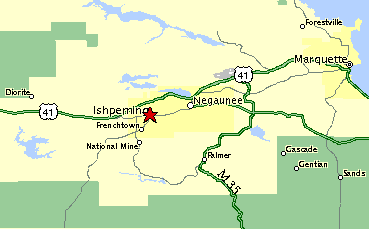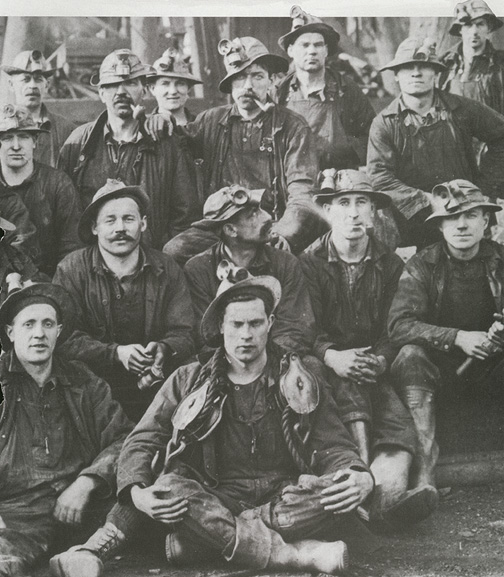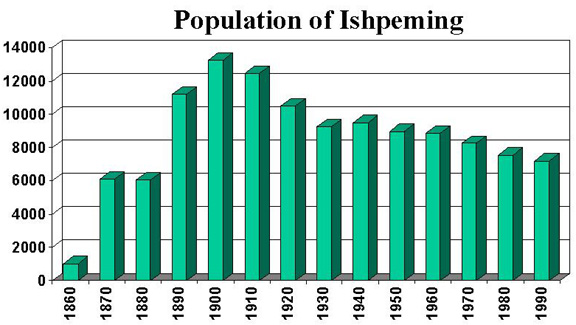ISHPEMING AND NEGAUNEE: BOOM/BUST TOWNS?
The cities of Ishpeming and Negaunee, located a few km west of Marquette on US 41, are
today small, sleepy towns with a great deal of history, and many old, tattered houses and
buildings. In the late 1800's, when iron mining was at its peak in the area, they
were much larger cities.

Source: Michigan State University - Department of Geography
It all started with the discovery of iron ore near Negaunee in 1844.
Negaunee and Ishpeming are located in the Marquette Iron Range.
Negaunee's first cabin was erected in 1846. Nine years later there were only six
houses in Negaunee. In 1855, 11 years after the ore was first dicovered, a visitor
noted, "very little in the way of amusement" in the town. Wolves, he said,
could be heard howling at night. By 1871, a village had finally emerged from where
previously had been tall trees and 4-foot deep mud. Visitors noted that the mud, in
1871, was now only a foot deep. It must have looked something like this:
In the late 19th century, American industry faced a labor relations
crisis--partly engendered by the growing size of business and the increasing economic and
social gap between employers and employees. Between 1880 and 1900 the United States
suffered 23,000 strikes. Many of these confrontations turned violent. To try to combat
labor discontent, some employers responded with harsh repression, hiring spies and armies
of security personnel to break strikes and intimidate workers. Labor, in response, turned
to revolutionary ideologies, vandalism and armed confrontation. In an attempt to find a
middle ground between these extremes, many corporations between 1880 and 1920 turned to paternalism.
Paternalism involves providing employees with company-controlled
amenities that are not required by law or negotiated contract, such as low-cost housing,
health care and recreational facilities. Through paternalism employers attempt to
influence the attitudes and morals of their employees and attract, maintain and control a
peaceful and reliable labor force.
Paternalistic practices were especially common in areas where workers
could not easily acquire privately offered goods and services. Thus, it is not surprising
that the isolated Michigan iron-mining companies, located throughout the sparsely
populated Upper Peninsula, were heavily involved in paternalism. Paternalism in
Michigan’s iron-mining regions began, however, not as a corporate weapon to quiet
worker discontent and combat unionization, but as business necessity. Michigan’s
Upper Peninsula was a cold, forbidding wilderness during much of the nineteenth century.
In summers its large, numerous swamps bred hosts of insects, making life miserable; in
winters it was frozen in by ice and snow. There were virtually no roads, and so getting
goods into the mining areas was expensive, if not impossible.
Paternalism in the UP iron mines was a give-and-take. The mines
provided cheap housing, garden plots where their employees could grow vegetables,
electricity, and even water. In many cases all these amenities cost the miners less than
$10 per month and much of that money was in bills that were not US currency but iron mine
currency---good only at the local iron mine store.
Married miners were rented individual houses, such as the row houses shown below, while
single miners lived in boarding houses. Company stores provided for most of the
"wants" of the miners, and in many cases were the largest stores within miles.
In return, the content miners were less likely to strike and to call for higher wages.
With the fall of the mining industry, people have left and the populations of these two
"boom towns" has fallen.
With the eclipse of mining interests in Michigan at the turn of the century, the
wealthy financiers moved west to the iron fields of Minnesota, but the immigrants stayed
on in the peninsular society largely created by their presence. Thus, iron towns like
Negaunee, Ishpeming, Marquette, and Escanaba continued to exist despite the number of
dying towns and rusting blast furnaces.
The hills below show the region near Ishpeming, in the heart of the
Marquette Iron Range, during the mid-20th century. This era was chosen because trees do
not block the view of the iron-rich hills. Today, regrowth of forest has
occurred. The hills are composed of iron-rich rocks like diorite, and other
"iron formations".
This structure is the shafthouse of the Cliffs-Shaft mine, in Ishpeming, one of only two iron mines in the city proper. By the turn of the century mines in Ishpeming were producing more than 2 million tons of ore per year. Shaft mines like this one were extremely prosperous and productive during the early 20th century.
Mine workers such as the ones shown below were the backbone of the mines. Six days a week of back-breaking labor in the mines fueled the industrial revolution of the United States and satiated the demand for iron that was growing almost daily.

Source: Photo courtesy of Michigan History Magazine

Source: Michigan State University - Department of Geography
This material has been compiled for educational use only, and
may not be reproduced without permission. One copy may be printed for personal
use. Please contact Randall Schaetzl (soils@msu.edu)
for more information or permissions.